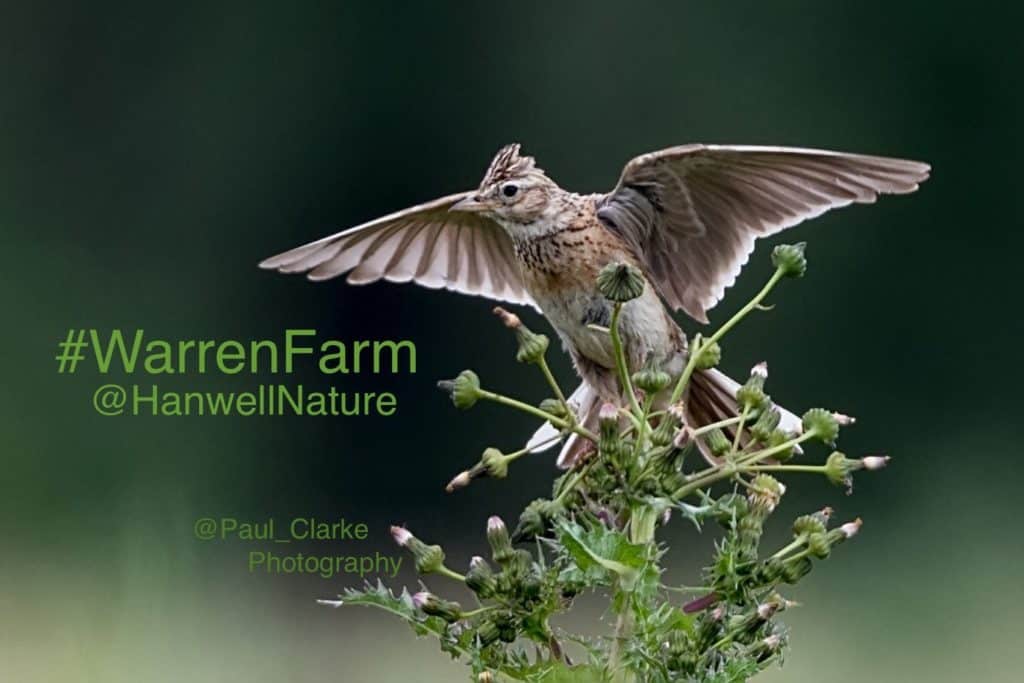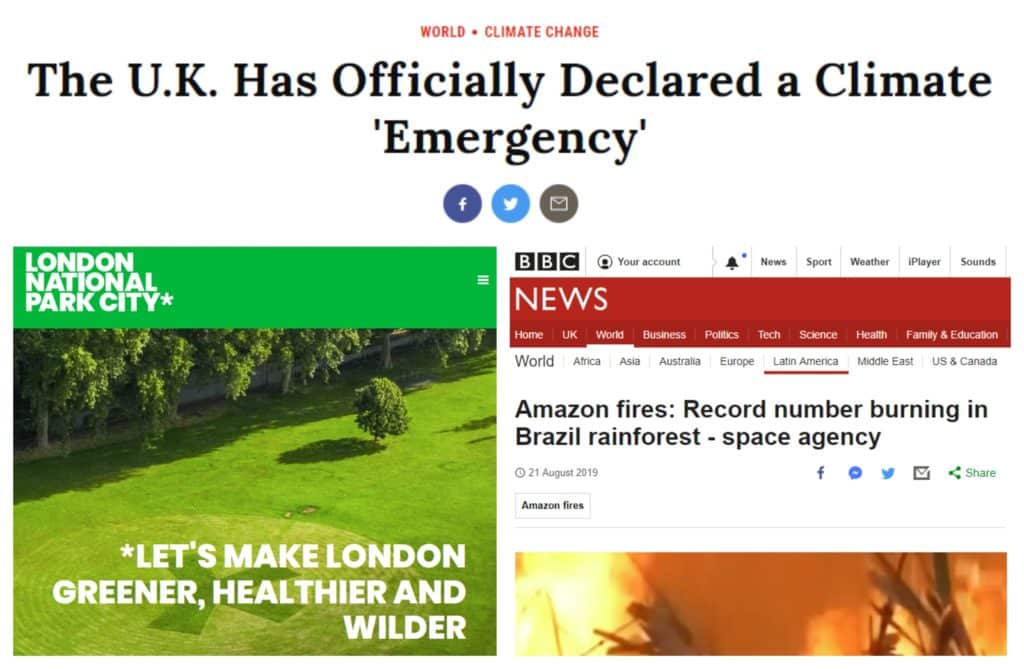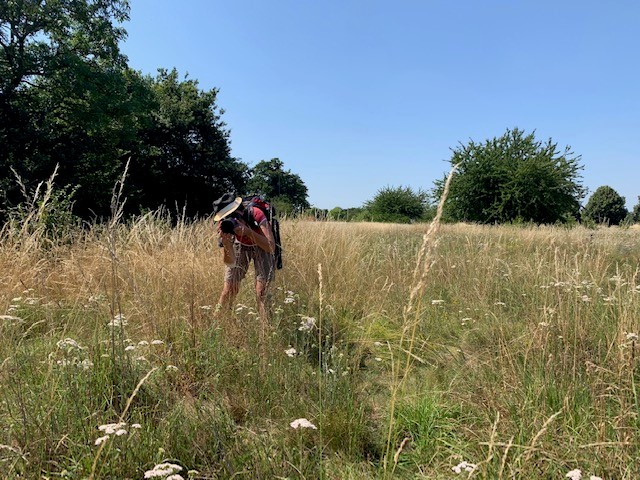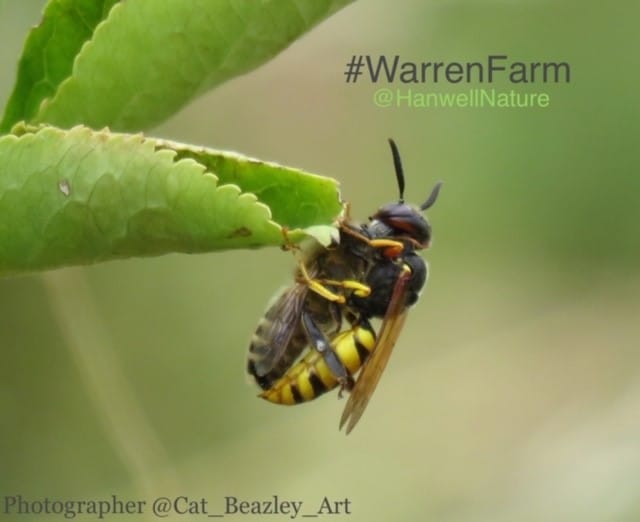Katie Boyles
A writer by day, Katie is an amateur recorder who has fallen in love with her local green space – Warren Farm. Her relationship with Warren Farm has taken her from being a dog-walker to a key member of a community group working to protect it. We asked Katie to write a short story on her journey so far.

Me on Warren Farm! (camouflage fail)
“What on Earth kind of bird even is that?” We walked, dogs at our feet, grateful for a break in the rain. As I pulled a dog poo bag out of my pocket, I stopped to look up at the bird in question. Like a rocket, the bird shot straight up into the air from the ground. Momentarily hovering before jauntily flying in a large oval shape. Singing like it had accordions for lungs, a warble so beautiful and so loud and then, just before it plummeted to the ground like it had forgotten how to fly, it let out a repeated single note that sounded like the kind of noises my brother and I used to make when firing water pistols at each other. Pew Pew Pew! “It’s a skylark.” I said, tying up the poo bag, my rescue dog grinning up at me. And on we walked.

Getting a dog meant having to walk twice a day. Walking meant discovering new green spaces. Warren Farm soon became our favourite park. Through a chance encounter with a muddy Bichon Frise and its patient owner I learned our land was due to be given by Ealing Council to a private company for a peppercorn rent (a quid) on a 200-year lease. I got home. Fed the dog. Flicked the kettle on. Sat down at my laptop to work… but my fingers googled s-k-y-l-a-r-k-s.
If you took a starling, slightly shrunk him, coloured him light brown, added a white flecked stomach and gave him a punk hair do – you have a skylark. Normally found in the countryside, they are ground-nesting birds on the UK Red List. Suffering at least 50% decline in population and 50% decline in breeding ground. They are of the highest conservation concern. Incredible to have them in London successfully breeding on Warren Farm. Incredible to have them at all.
This is how it started.
Warren Farm is nestled between Southall and Olde Hanwell in West London. 4.7 miles (as the crow flies) from Heathrow Airport. 0.7 miles from the M4 motorway. No surprises, in the past, Warren Farm was indeed a farm. Then football pitches. And now? A stunning experimental rewilding has occurred on a grand scale. It’s 61 acres of Metropolitan Open Land (MOL). A rich mix of neutral and acid grassland. A Biodiversity Action Plan (BAP) priority habitat. It has a Site of Importance for Nature Conservation (SINC) that runs along an ancient hedgerow. It’s part of Brent River Park known as the ‘Lungs of London’. The Mayor of London, Sadiq Khan prioritises acid grassland for protection in The London Plan. Warren Farm is voted by park goers as one of the top four parks in London, the only park in the borough of Ealing to be runner-up, making it a ‘Much Loved’ 2019 green space by Fields in Trust. Basically, I discovered it’s right up there in terms of priority conservation importance.

The UK has since become the first country in the world to announce a Climate Emergency. London has become the first city in the world to be declared a National Park City. The ecology report carried out on Warren Farm concluded the land had ‘little to no ecological value’ and that it was ‘species poor.’ And as us humans watch the ‘Lungs of the World’, the Amazon rainforest burn before us, it is against this backdrop the skylarks on Warren Farm continued to sing.
“I think I’m going to find a way to record what’s here.” I announce to my dog as he merrily ate rabbit poo. I figured at the very least the creatures that live here deserve to have their existence acknowledged. Somewhere that matters. I had no idea what I was doing. I just knew, whatever the outcome, that it was the right thing to do and that out there somewhere, someone would help. Wouldn’t they?
When you fall down a rabbit hole, expect to find carrots

Peter Edwards holding an invisible cup of tea
I met botanist, cyclist, generous allotment-giver Peter Edwards whilst offering to pick up a dog poo (not from mine) outside of his home. Yes, there is a running theme here. And together one day we walked onto Warren Farm. Accessing 61 acres is no small task. For scale – Warren is bigger than Ealing parks Lammas and Walpole put together. St James’s Park, one of the most famous royal parks in London, is smaller than Warren Farm at 57 acres. “Well.” Said Peter, always cheery and upbeat. “We best be getting on with it I suppose!” Peter, armed with a pencil, a small note pad and a lifetime of botanical knowledge and surveying. Me, armed with an iPhone, a plant recognition app and a bar of melted chocolate. I quickly became the annoying kid in the back seat. “What’s that plant called?” “And that plant?” “How the hell do you spell that? Latin? Seriously!?”
I had walked on Warren Farm maybe 3 years and now it was like a curtain had been lifted and I was seeing a piece of land I had taken for granted in a completely new light. Suddenly every blade of grass had a name and story behind it. Every plant a history, a purpose, an invaluable contribution to the ecosystem.
In trying to ‘help’ I offered to take a photo of a plant Peter took a sample of – “One to run past the Kew Gardens Herbarium and the London Natural History Society.” he said. I whip out my iPhone and upload the photo to a plant identification app, so was my confidence in technology and the internet. Peter laughed. “Yes, all very nice but you won’t get an answer on this plant. It’s very rare you see.” He said, plucking a giant spiky leaf off another nearby plant – and EATING IT. My face gave away my horror. “Lettuce family. Would you like some?” he munched. “I got chocolate, but thanks.”
I checked my app. Zero matches to the mystery plant. Peter was right. He consoled me by saying how useful it was that I was taking photos as he doesn’t have a phone that can do ‘all that stuff’. He was Gandalf and I was definitely Frodo. But where old meets new, where paper meets computer, I was able to add Peter’s amazing findings to a spreadsheet. Together (but let’s face it – mostly Peter) we found a way. And so it went.
Like watching an episode of QI or University Challenge, you know if you remember one fact or get one thing right you feel like a champion – that’s how I felt assisting records on Warren Farm. But the cool thing is I now know what a wild carrot looks like, that it has a little dark purple flower in the middle of an umbrella of white flowers which enables it to attract more insects for pollination – who are fooled into thinking the little purple flower is already an insect dining out there. Who knew. Carrots are clever. And that the carrots we eat today were cultivated from this wild carrot ancestor. I know right!?
#plantlove #plantsmakepeoplehappy #plantsofinstagram #plantfacts #OMGplants
I’ve learnt that sometimes the most interesting and rare plants aren’t the biggest, most intricate, most colourful flowering. They can be the innocuous green, blink and you’ll miss them plants that take up no more space than a rich tea biscuit but that are integral to the habitat and insects that depend on them. Finding plants growing on Warren Farm on the UK vulnerable and extinction list both blew my mind and struck at my heart. “How is it these plants have been allowed to get this close to becoming extinct?” I ask. Peter gives a sad shake of the head.
Ideally you accurately assess a piece of land over the course of a year. In 10 weeks, over 250 plant species were discovered on Warren Farm. Mark A. Spencer, mega botanist-extraordinaire, writer of books, recorder of Middlesex, continues to help us add and verify records. Phil Belman, bearded brilliance, a British Trust for Ornithology (BTO) expert which means he and his courageous daughter Aisha get to climb trees and ring the legs of little owls (Athene noctua) – helped me record birds alongside many other bird watchers. One of whom shared with me how she used to watch the birds on Warren Farm from a window at Ealing Hospital where she worked, armed with just a pair of binoculars and a rushed lunch time cheese sandwich – before heading over after a long shift in the hope of getting a closer look. I am yet to meet an ungenerous birder or botanist.
Along the way I soon discovered there are a lot of people out there who care deeply about Warren Farm. Groups and individuals who have fought long and hard to protect the land from development in a myriad of different ways. And they have been doing this for years, for some, a lifetime– each out of their own intrigue, passion and concern over this special biodiversity-rich piece of land. Each with their own professional and amateur ways of working. All as important. We needed a memorable team name and The Avengers had been taken so…

Hanwell Nature was born in May 2019 because deep down, we all knew that the creatures and plants who survive and depend on Warren Farm for their existence can’t speak for themselves. We each need to take responsibility to do that for them. And not just on Warren Farm, but across all the green spaces we love and take for granted. From the trees that line a street, the busy green roundabout surrounded by cars, to the bursting with nature local parks you can’t possibly imagine anyone would ever want to destroy, places just like Warren Farm – I learnt that recording species is imperative to our combined knowledge on the environmental state of our boroughs, cities and yes let’s go there, to the entire planet – our shared home.
Taking a #thinkglobalactlocal approach to our surroundings brings people together with a common interest in precious habitats as unique and rich in biodiversity as Warren Farm is. It means no green space gets overlooked (or under-looked). It allows ideas and discoveries to be shared. One species record at a time. With essential recording bodies like the knowledgeable and friendly gurus Greenspace Information for Greater London CIC (GiGL), the mighty impressive LNHS and others, the flora and fauna spotted on a walk get logged. Forever. If the dog and I can learn to spot a toadflax brocade caterpillar, anyone can.
Bird watchers and photographers were some of the first people to answer Hanwell Nature’s call out for help to record the wildlife spotted on Warren Farm. Professional photographer Paul Clarke, never photographed a bird in his life, was the first to answer the call for someone to photograph the skylarks. He arrived like a knight in shining armour on a motorbike with a camera for a sword. The photos speak for themselves. Ted Davis, techie and Caesar salads connoisseur, was the first to take photos of the breeding mistle thrushes. Another bird on the UK Red List of the highest conservation concern. Red kites, linnets, meadow pipits, little owls, barn owls, kestrels, woodpeckers, starlings, swifts… the list of birds dependent on Warren Farm goes on.





Out of the 25 photographers we approached, only 1 had to decline. All had the kind of patience I can only dream of having. I am now saving up for my own camera. I have caught the bug. Or the bird. Depending on which direction I’m looking. The photos they shared with us capture more than just the beauty of the bird itself, but of the realisation that each bird seen on Warren Farm, nesting, feeding and breeding is here because nature has been allowed to rewild and recover. At a time when we need it the most.
Sophie Leguil, tenacious botanist and passionate insect expert found us on twitter and called us from France. “Have you had anyone look at the insects? I can fly to London tomorrow.” On the hottest day of the year so far, in the lunch time heat, Sophie and I donned straw hats. A camera slung around her neck, a couple of sample tubes in her pockets. With hawk-like accuracy, Sophie spotted and captured insects I must have walked past a thousand times or more. “So many butterflies!” “Adonis ladybird.” (Hippodamia variegata). ‘Slender-horned leatherbug.” (Ceraleptus lividus).

“A beewolf!” (Philanthus triangulum) Her tone lowered. “This one is vulnerable.” I didn’t know that insects had a Red List too. Of course they do. Why did I think otherwise? Why had I not looked down more often? Why had I not stopped to look closer at the insects that we humans rely on for our own existence. Since meeting Sophie and Catherine Beazley, a nature enthusiast with a love for insects who was inspired to visit Warren Farm, I no longer simply brush a fly aside if our paths cross. I try to take a photo. I log the location. Date. Time. And if I don’t know what it is, I reach out and ask someone who does.
Something has to change.
As enjoyable and amazing and mind-blowing an experience recording nature on Warren Farm has been, it is in equal measure – heart-breaking. There are species here on Warren Farm, across the UK and the world that we humans are knowingly allowing to be pushed into vulnerable and extinction Red Lists. Looking back now over the ecology report undertaken on Warren Farm, the one that said our land had ‘little to no ecological value’ and was ‘species poor’ – that report was a large contributor as to why Warren Farm was placed under threat of development. The lack of a comprehensive evidence base, observations taken consistently over time with records sent to places like GiGL, meant that the species seen thriving on Warren Farm have been left without a voice in the decision-making process, until now. Skylarks can’t send emails telling the world they are breathing and struggling to survive against the odds – they can only sing to those willing to stop and listen – and record. What if this species-rich park was protected as Warren Farm Nature Reserve – an environmental, educational and cultural centre, open to all? Something has to change. Because if it doesn’t, Warren Farm and many other valuable green spaces across the country, once lost, will be lost forever.
I grab the dog’s lead. “Do you want to go for a walkies?” I don’t know why I ask this question. The answer is always a waggy yes. “Warren Farm – let’s go!” And we pass and say good morning to joggers too exhausted to speak so instead they nod, bird watchers their faces obscured by binoculars, blackberry pickers the edges of their mouths stained purple, walkers taking the time to watch the rabbits, sniff flowers and just – be, a yoga group reach up to the sky whilst balancing on one leg breathing in on the count of three to the chirping sounds of crickets, the Warren Farm Radio Flyers who have been here over 22 years, teach a newcomer how to fly a model plane without crashing as watched by a circling red kite, a family picnic under the trees watch the starling murmuration swirl, a mum with a butterfly book points out a peacock butterfly to her little girl who squeals in delight. If it sounds pretty darn idyllic. That’s because it is.
I hear the skylark before I spot him. His song bursting from his chest as he circles high above me. “We’ll add him to today’s list.” The dog doesn’t hear me. He’s too busy sniffing a hedgehog poo. “Nice find! Good boy.”


